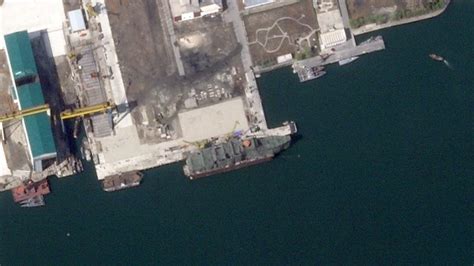
A North Korean frigate, previously seen partially submerged, has been observed upright in satellite imagery taken on May 20, 2024, after an extended period of being tilted. The images, analyzed by Radio Free Asia (RFA), indicate that the vessel, located at the Nampo naval shipyard on the west coast of North Korea, is now fully surfaced, although the reasons behind the initial submergence and subsequent recovery remain unclear.
New satellite imagery reveals that a North Korean warship, which had been listing in the water for an extended period, has been righted. The frigate, situated at the Nampo naval shipyard, was observed fully upright in images taken on May 20, 2024, according to a report by Radio Free Asia (RFA). The vessel had been partially submerged for an undetermined length of time, raising questions about its operational status and the capabilities of North Korea’s naval maintenance and repair facilities.
The RFA report, citing imagery from Planet Labs, shows a distinct change in the vessel’s position compared to earlier observations. “The warship, which had been listing for a considerable period, is now upright,” the RFA stated, based on analysis of the satellite images. While the imagery confirms the change, it provides no definitive explanation for the ship’s initial state or the reasons behind its recovery.
The Nampo shipyard, one of North Korea’s primary naval construction and repair facilities, is strategically important for maintaining and upgrading the country’s aging fleet. The presence of a partially submerged warship at such a facility raised concerns about the state of North Korea’s naval infrastructure and its ability to maintain its warships. The recent imagery suggesting the vessel has been righted may indicate a successful salvage operation, although details remain scarce.
The type of frigate involved has not been definitively identified, but analysts speculate it is likely one of the older vessels in North Korea’s fleet. North Korea operates a mix of domestically built and older, imported warships, many of which are believed to be in need of modernization or replacement. The incident at Nampo highlights the challenges North Korea faces in maintaining its naval capabilities amid international sanctions and economic constraints.
Further analysis of the satellite imagery and any available open-source intelligence may provide additional clues about the vessel’s condition, the extent of any damage it may have sustained, and the purpose of its presence at the Nampo shipyard. The incident underscores the importance of monitoring North Korea’s military activities and infrastructure, particularly in light of ongoing tensions in the region.
Background on North Korean Naval Capabilities
North Korea’s navy is primarily a coastal defense force, focusing on protecting its territorial waters and supporting ground operations. The fleet consists of a mix of small surface combatants, submarines, and patrol boats. While North Korea possesses a relatively large number of naval vessels, many are outdated and lack advanced technology.
The country’s submarine fleet is one of the largest in the world, but it primarily consists of older, diesel-electric submarines. These submarines are capable of posing a threat to enemy vessels, but their operational range and capabilities are limited compared to modern submarines.
North Korea has also been developing new naval capabilities, including the construction of new submarines and the development of submarine-launched ballistic missiles (SLBMs). These developments have raised concerns about North Korea’s ability to project power and deter potential adversaries.
The Nampo shipyard is a key facility for North Korea’s naval modernization efforts. The shipyard is capable of constructing and repairing a variety of naval vessels, including submarines and surface combatants. The incident involving the partially submerged frigate highlights the challenges North Korea faces in maintaining its naval infrastructure and keeping its fleet operational.
Potential Reasons for the Submergence and Recovery
Several factors could have contributed to the frigate’s partial submergence and subsequent recovery. These include:
- Accidental Flooding: The vessel may have experienced accidental flooding due to a hull breach or equipment malfunction. This is a common occurrence in aging ships, particularly those that are not properly maintained.
- Maintenance or Repair Work: The frigate may have been undergoing maintenance or repair work at the shipyard, and the partial submergence may have been related to these activities. For example, the ship may have been intentionally submerged to allow for repairs to be carried out on its hull.
- Deliberate Grounding: The vessel may have been deliberately grounded in shallow water for an unknown reason. This could have been done to protect the ship from damage during a storm or to facilitate certain types of repair work.
- Salvage Operation: If the vessel had sunk or partially sunk due to an accident, the recent activity could indicate a salvage operation to raise and repair the ship.
- Decommissioning Preparations: Although less likely, the ship might have been in the process of being decommissioned. Partially submerging it could be part of a process to strip it of useful materials before final disposal.
The exact reason for the incident remains unclear without further information. However, the satellite imagery confirms that the vessel has been successfully righted and is now fully surfaced.
Implications for Regional Security
The incident involving the North Korean frigate highlights the ongoing challenges to regional security in Northeast Asia. North Korea’s continued development of its military capabilities, including its naval forces, poses a threat to its neighbors and the broader international community.
The United States and its allies, including South Korea and Japan, have been closely monitoring North Korea’s military activities and have been working to deter further provocations. The United Nations Security Council has imposed sanctions on North Korea in an effort to curb its nuclear and missile programs.
The incident involving the frigate serves as a reminder of the need for continued vigilance and diplomacy to address the challenges posed by North Korea. It also underscores the importance of maintaining a strong and credible deterrent to prevent further escalation of tensions in the region.
Analysis of the Satellite Imagery
The satellite imagery from Planet Labs provides valuable information about the incident involving the North Korean frigate. The imagery shows the vessel in two different states: partially submerged and fully surfaced.
By analyzing the imagery, experts can gain insights into the vessel’s condition, the extent of any damage it may have sustained, and the nature of the operations that were carried out at the Nampo shipyard. The imagery can also be used to track changes in the vessel’s position over time and to monitor activity at the shipyard.
Satellite imagery is an increasingly important tool for monitoring military activities around the world. It provides a relatively inexpensive and unobtrusive way to gather information about potential threats and to verify compliance with international agreements.
In the case of North Korea, satellite imagery is particularly valuable because it is difficult to obtain information through other means. North Korea is a closed society, and access to the country is tightly restricted. Satellite imagery provides a window into North Korea’s military activities that would otherwise be unavailable.
Potential Impact on North Korean Naval Operations
The incident involving the frigate could have a number of potential impacts on North Korean naval operations. If the vessel sustained significant damage, it may be out of service for an extended period of time, reducing North Korea’s overall naval capabilities.
The incident may also lead to increased scrutiny of North Korea’s naval maintenance and repair practices. If the submergence was caused by negligence or inadequate maintenance, it could prompt reforms within the North Korean navy.
The incident could also have a psychological impact on North Korean naval personnel. The sight of a partially submerged warship could undermine morale and confidence in the navy’s capabilities.
Overall, the incident involving the North Korean frigate is a significant event that could have a range of potential impacts on North Korea’s naval operations and regional security.
The Importance of Open-Source Intelligence
The report by Radio Free Asia (RFA) highlights the importance of open-source intelligence (OSINT) in understanding events in North Korea. OSINT refers to information that is publicly available, such as satellite imagery, news reports, and social media posts.
By analyzing OSINT, experts can gain valuable insights into events that would otherwise be difficult to obtain information about. In the case of North Korea, OSINT is particularly important because access to the country is tightly restricted.
The RFA report demonstrates how OSINT can be used to track military activities, monitor infrastructure, and assess the state of North Korea’s economy and society. OSINT is an increasingly valuable tool for policymakers, analysts, and journalists who are trying to understand the challenges posed by North Korea.
North Korea’s Response to the Incident
As of the latest reports, North Korea has not publicly commented on the incident involving the frigate. This is not unusual, as North Korea often does not acknowledge incidents involving its military assets, particularly if they are embarrassing or reflect poorly on the country’s capabilities.
However, it is likely that North Korea is aware of the international attention that the incident has attracted. The North Korean government may be taking steps to limit the spread of information about the incident within the country.
It is also possible that North Korea will attempt to use the incident to its advantage. For example, North Korea may claim that the incident was caused by external factors, such as sabotage, or that it demonstrates the need for increased military spending.
FAQ: North Korean Frigate Incident
1. What happened to the North Korean frigate?
Satellite imagery shows that a North Korean frigate, located at the Nampo naval shipyard, was previously partially submerged but has now been observed upright. The reasons for its initial state and subsequent recovery are not definitively known.
2. Where is the frigate located?
The frigate is located at the Nampo naval shipyard, which is on the west coast of North Korea.
3. When was the frigate observed upright?
The satellite imagery showing the frigate upright was taken on May 20, 2024.
4. Why was the frigate partially submerged?
The reasons for the frigate’s partial submergence are currently unknown. Potential causes include accidental flooding, maintenance or repair work, or deliberate grounding.
5. What are the implications of this incident?
The incident highlights the challenges North Korea faces in maintaining its aging naval fleet and infrastructure. It also underscores the importance of monitoring North Korea’s military activities and capabilities. The complete recovery of the ship also demonstrates some degree of repair capability within North Korea.
Further Expansion and Analysis
The incident involving the North Korean frigate at the Nampo shipyard can be viewed through multiple lenses to provide a more comprehensive understanding. These include analyzing the geopolitical context, evaluating the technological capabilities involved in the salvage operation (if it was indeed a salvage), and assessing the broader implications for North Korea’s strategic signaling.
Geopolitical Context:
The Korean Peninsula remains a region of high geopolitical tension. North Korea’s pursuit of nuclear weapons and ballistic missiles has led to international sanctions and strained relations with the United States, South Korea, and Japan. The country’s military activities, including naval operations, are closely monitored by regional and international actors. Any incident involving North Korean military assets can be interpreted as a potential indicator of the country’s intentions and capabilities.
In this context, the submergence and recovery of the frigate could be interpreted in several ways. Some analysts might see it as a sign of weakness, reflecting the challenges North Korea faces in maintaining its military equipment due to economic constraints and sanctions. Others might view it as a demonstration of resilience, indicating that North Korea is capable of repairing and maintaining its naval assets despite these challenges.
The incident also occurs against the backdrop of increasing military activities in the region. The United States and South Korea regularly conduct joint military exercises, which North Korea views as provocative. North Korea has also been conducting its own military exercises, including missile launches and naval drills. The incident involving the frigate could be seen as part of this broader pattern of military activity.
Technological Capabilities:
If the recovery of the frigate involved a salvage operation, it would provide insights into North Korea’s technological capabilities in this area. Salvage operations can be complex and require specialized equipment and expertise. The fact that North Korea was apparently able to successfully right the vessel suggests that it possesses some level of competence in this field.
However, it is important to note that the extent of the damage to the frigate and the complexity of the salvage operation are unknown. It is possible that the vessel only sustained minor damage and that the salvage operation was relatively straightforward. It is also possible that North Korea received assistance from other countries in the salvage operation, although there is no evidence to support this.
Regardless of the details, the incident highlights the importance of assessing North Korea’s technological capabilities in various fields. This is essential for understanding the country’s military potential and for developing effective strategies for deterring and responding to potential threats.
Strategic Signaling:
The incident involving the frigate could also be interpreted as a form of strategic signaling. Strategic signaling refers to actions that are intended to communicate a message to other actors. In this case, North Korea might be using the incident to send a message about its resolve, its capabilities, or its intentions.
For example, by successfully righting the frigate, North Korea might be trying to demonstrate its resilience and its determination to maintain its military capabilities despite international pressure. Alternatively, North Korea might be trying to send a message about its willingness to take risks or its dissatisfaction with the current state of affairs.
It is important to note that strategic signaling can be difficult to interpret. The meaning of an action can be ambiguous, and different actors may interpret it in different ways. However, by carefully analyzing the context and the available information, it is possible to gain insights into the messages that North Korea is trying to send.
Impact of Sanctions:
The United Nations Security Council has imposed a series of sanctions on North Korea in response to its nuclear and missile programs. These sanctions are intended to restrict North Korea’s access to resources and technology that could be used to develop these programs.
The incident involving the frigate highlights the potential impact of these sanctions on North Korea’s military capabilities. The fact that the vessel was partially submerged could be a reflection of the challenges North Korea faces in maintaining its military equipment due to economic constraints and limited access to spare parts and technology.
However, it is also important to note that sanctions are not always effective. North Korea has been able to circumvent some sanctions through various means, including smuggling and cybercrime. The incident involving the frigate could also be seen as evidence of North Korea’s ability to adapt and overcome the challenges posed by sanctions.
Future Developments:
It is likely that further information about the incident involving the North Korean frigate will emerge in the coming weeks and months. This could include additional satellite imagery, news reports, and analysis from experts.
It is important to continue to monitor developments in North Korea closely and to analyze any new information that becomes available. This will help to provide a more comprehensive understanding of the country’s military capabilities and its strategic intentions.
Conclusion:
The incident involving the North Korean frigate at the Nampo shipyard is a complex event with multiple potential interpretations. It highlights the challenges North Korea faces in maintaining its aging naval fleet, the country’s technological capabilities, and the impact of international sanctions. The incident also underscores the importance of monitoring North Korea’s military activities and strategic signaling. By analyzing the available information and considering the broader geopolitical context, it is possible to gain valuable insights into the challenges posed by North Korea and the strategies for addressing them. The event serves as a reminder of the constant need for vigilance and in-depth analysis to comprehend the complex dynamics of the Korean Peninsula and its implications for regional and global security. The complete picture requires not only monitoring overt actions but also understanding the underlying motivations and constraints driving North Korea’s behavior.









